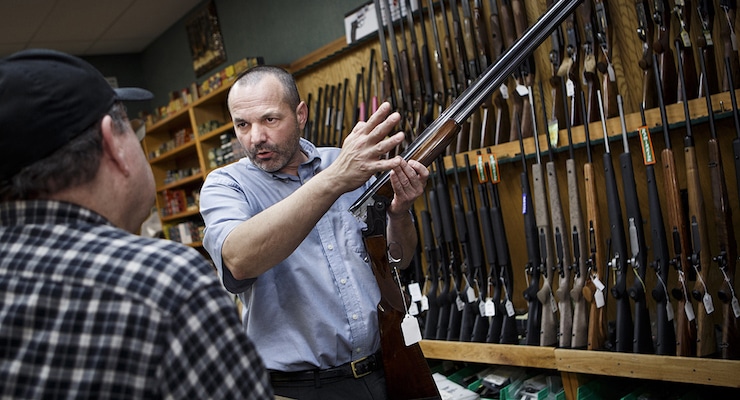
Redding Vice mayor and the owner of a gun shop Patrick Jones, right, shows a customer, John Robinson of Redding a shotgun in his store, February 19, 2013. Shasta County has the highest per-capita rate of gun background checks, indicating attempts to buy firearms, of any county in California, which has some of the nation’s strictest gun laws. (Photo: Dai Sugano/San Jose Mercury News/MCT)
While I dismiss conspiracy theories that presume there’s a plan in Washington to strip away our rights, I do think there’s a natural “public choice” explanation for ever-growing, ever-more powerful government. And that can lead to ever-expanding examples of abusive mistreatment of citizens.
If you don’t believe me, just ask people like Andy Johnson, Anthony Smelley, the Hammond family, Charlie Engle, Tammy Cooper, Nancy Black, Russ Caswell, Jacques Wajsfelner, Jeff Councelller, Eric Garner,Martha Boneta, Carole Hinders, Salvatore Culosi, and James Lieto, as well as the Sierra Pacific Company and the entire Meitev family.
the Hammond family, Charlie Engle, Tammy Cooper, Nancy Black, Russ Caswell, Jacques Wajsfelner, Jeff Councelller, Eric Garner,Martha Boneta, Carole Hinders, Salvatore Culosi, and James Lieto, as well as the Sierra Pacific Company and the entire Meitev family.
Here’s something else to worry about, especially considering the way citizens are increasingly mistreated by callous officials.
Former Senator Tom Coburn, along with Adam Andrzejewski of OpenTheBooks.com, wrote a column for the Wall Street Journal about the militarization of the bureaucracy.
Special agents at the IRS equipped with AR-15 military-style rifles? Health and Human Services “Special Office of Inspector General Agents” being trained by the Army’s Special Forces contractors? The Department of Veterans Affairs arming 3,700 employees? The number of non-Defense Department federal officers authorized to make arrests and carry firearms (200,000) now exceeds the number of U.S. Marines (182,000). In its escalating arms and ammo stockpiling, this federal arms race is unlike anything in history. Over the last 20 years, the number of these federal officers with arrest-and-firearm authority has nearly tripled to over 200,000 today, from 74,500 in 1996. …During a nine-year period through 2014, we found, 67 agencies unaffiliated with the Department of Defense spent $1.48 billion on guns and ammo. Of that total, $335.1 million was spent by agencies traditionally viewed as regulatory or administrative, such as the Smithsonian Institution and the U.S. Mint.
Here are some of the strange example of militarized bureaucracy, along with my speculation as to why the paper pushers ostensibly need heavy weapons.
the paper pushers ostensibly need heavy weapons.
The Internal Revenue Service, which has 2,316 special agents, spent nearly $11 million on guns, ammunition and military-style equipment. That’s nearly $5,000 in gear for each agent.
Perhaps the IRS bureaucrats expected Tea Party groups to fight back after they were suppressed to help Obama’s reelection?
The Department of Veterans Affairs, which has 3,700 law-enforcement officers guarding and securing VA medical centers, spent $11.66 million. It spent more than $200,000 on night-vision equipment, $2.3 million for body armor, more than $2 million on guns, and $3.6 million for ammunition. The VA employed no officers with firearm authorization as recently as 1995.
Were the VA bureaucrats worried that angry veterans who were put on secret waiting lists might get violent instead of simply dying?
The Animal and Plant Health Inspection Service spent $4.77 million purchasing shotguns, .308 caliber rifles, night-vision goggles, propane cannons, liquid explosives, pyro supplies, buckshot, LP gas cannons, drones, remote-control helicopters, thermal cameras, military waterproof thermal infrared scopes and more.
I don’t even know what propane cannons and LP gas cannons are, but they sound almost as awesome as a tank, so why not get them if taxpayers are footing the bill?
The Environmental Protection Agency spent $3.1 million on guns, ammunition and military-style equipment. The EPA has put nearly $800 million since 2005 into its “Criminal Enforcement Division.”
Is the EPA’s assault on illegal ponds really that dangerous?
The Food and Drug Administration employs 183 heavily armed “special agents.”
What’s the point of having milk police if they aren’t well armed?
The University of California, Berkeley acquired 14 5.56mm assault rifles and Yale University police accepted 20 5.56mm assault rifles from the Defense Department. Texas Southern University and Saddleback College police even acquired Mine Resistant Vehicles (MRVs).
There are rumors that very dodgy characters sometimes show up on campuses, so who am I to question the need for heavy weapons?
And there are other bureaucracies to add to this list, which doesn’t make Corburn and Andrzejewski very happy.
Other paper-pushing federal agencies with firearm-and-arrest authority that have expanded their arsenals since 2006 include the Small Business Administration, Social Security Administration, National Oceanic and Atmospheric Administration, Education Department, Energy Department, Bureau of Engraving and Printing, National Institute of Standards and Technology and many others. …the federal government has become a gun show that never adjourns. Taxpayers need to tell Washington that police powers belong primarily to cities and states, not the feds.
By the way, I have no objection to armed guards stationed at federal buildings. There are wackos out there. And I’m completely in favor of armed Energy Department  officials guarding nuclear facilities.
officials guarding nuclear facilities.
But do we really need armed regulators interacting with the public?
Yes, bureaucrats occasionally have to deal with potentially dangerous people. And even if they’re enforcing rules that shouldn’t exist, I think they have every right to be protected. But in those rare instances, why not simply call up the local cops and ask for an escort? Would that really be asking too much?
Jeff Jacoby is similarly irked by the militarization of the bureaucracy. Here’s some of what he wrote for the Boston Globe.
…consider one domestic organization’s fearsome arsenal of military-style equipment. In the space of eight years, the group amassed a stockpile of pistols, shotguns, and semiautomatic rifles, along with ample supplies of ammunition, liquid explosives, gun scopes, and suppressors. In its cache as well are night-vision goggles, gas cannons, plus armored vests, drones, and surveillance equipment. Between 2006 and 2014, this organization spent nearly $4.8 million to arm itself. Yet its aggressive weapons buildup has drawn almost no public attention. …It is the Animal and Plant Health Inspection Service, an agency of the US Department of Agriculture, that has built up such a formidable collection of munitions. And far from being an outlier, it is one of dozens of federal agencies that spends lavishly on guns, ammunition, and military-style equipment.
I guess the APHIS bureaucrats must run into ISIS terrorists. Or something like that.
But the more serious point, which Jeff astutely addresses, is whether militarized bureaucrats send the wrong message.
Between 2006 and 2014, the report shows, 67 federal bureaus, departments, offices, and services spent at least $1.48 billion on ammunition and materiel one might expect to find in the hands of SWAT teams, Special Forces soldiers — or terrorists. …the arms race has metastasized to federal agencies with strictly regulatory or administrative functions. The Internal Revenue Service, for example, now spends more than $1 million annually on firearms, ammunition, and military gear, double what it was spending a decade ago. Since 2006, the Department of Veterans Affairs — which has been sharply criticized for episodes of fatal incompetence in patient care — has poured nearly $11.7 million into guns and ammo. …Incredibly, there are now fewer US Marines than there are officers at federal administrative agencies with the authority to carry weapons and make arrests. …this federal arsenal alarms Adam Andrzejewski, the head of American Transparency’s OpenTheBooks.com, which researched and assembled the new report. “Just who,” he asks, “are the feds planning to battle?”
As I said at the start of this column, I don’t think bureaucrats are “planning to battle” anyone.
But I am concerned that a bloated government with vast and growing powers is a recipe for an ugly and unfortunate encounters.
Especially when we have a tax code and regulatory apparatus that make all of us criminals even when we’re trying to obey.
[mybooktable book=”global-tax-revolution-the-rise-of-tax-competition-and-the-battle-to-defend-it” display=”summary” buybutton_shadowbox=”true”]






